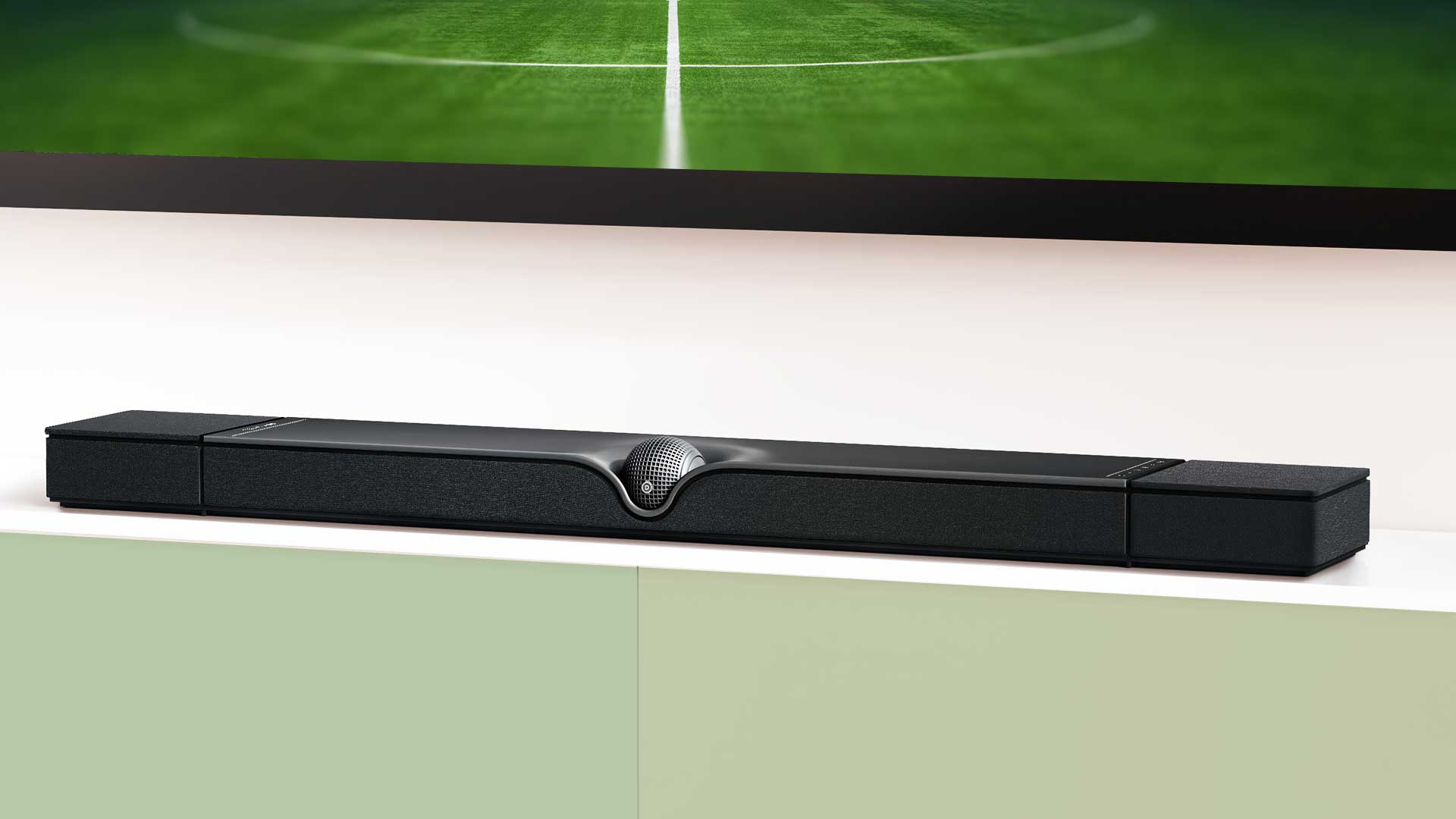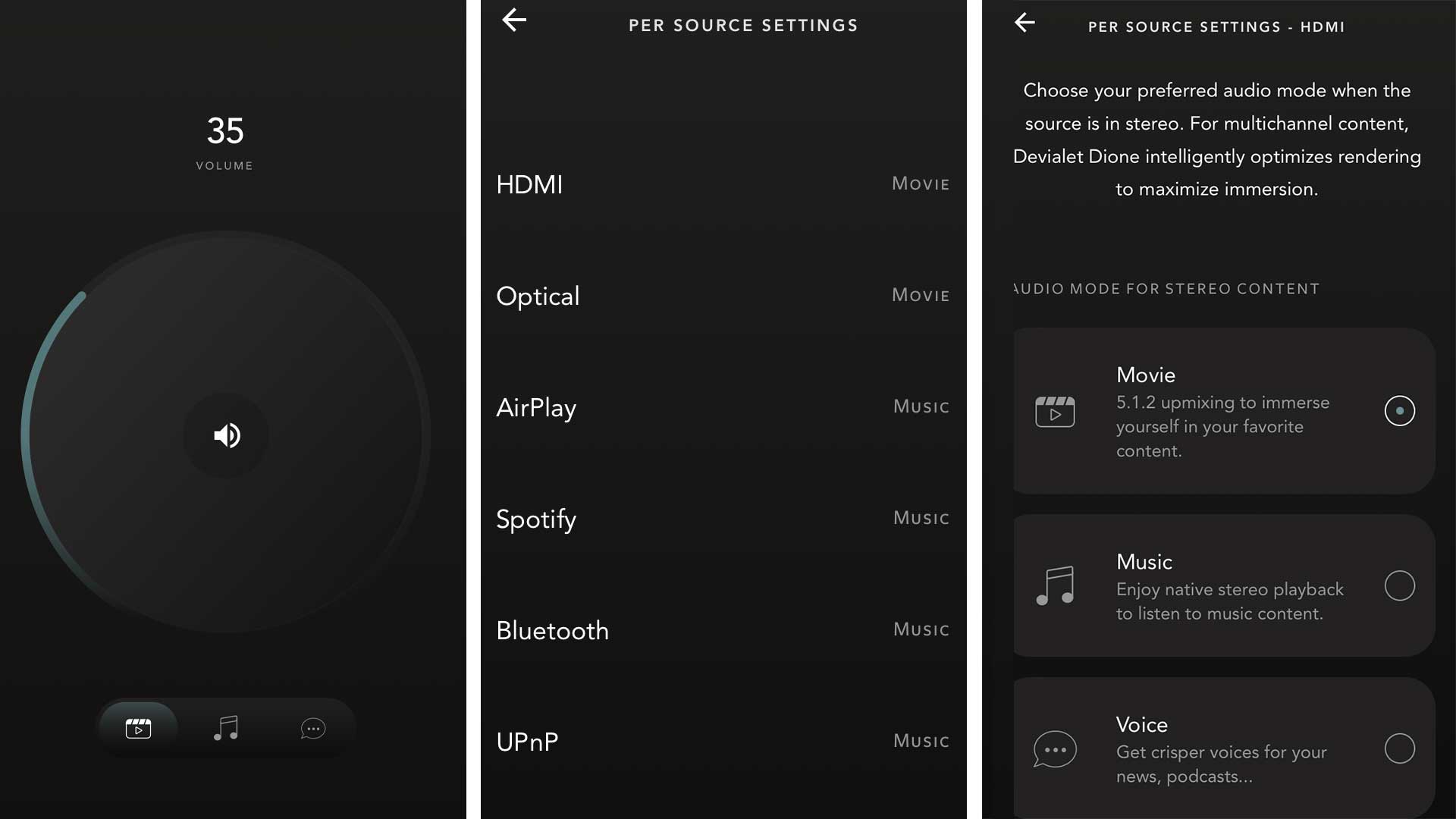Sound+Image Verdict
The convenience of a one-box soundbar, along with impressive design and performance far beyond that expected of the genre. When cranked with an Atmos soundtrack, the Devialet Dione can amaze with its spread, size and depth of sound – no subwoofer required.
Pros
- +
Excellent sound...
- +
... for movies and music too
- +
Networked music streaming
- +
No subwoofer required
Cons
- -
Price
- -
Some playback issues in our system
Why you can trust What Hi-Fi?
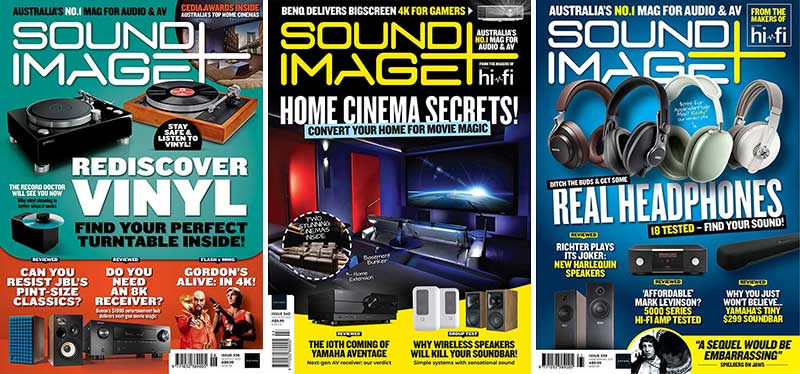
This review originally appeared in Sound+Image magazine, one of What Hi-Fi?’s Australian sister publications. Click here for more information on Sound+Image, including digital editions and details on how you can subscribe. Read What Hi-Fi?'s global, star-rated Devialet Dione review.
If you thought the likes of Bowers & Wilkins Panorama 3 soundbar here represents an upmarket offering, well, perhaps you aren’t looking high enough. If you crane your neck rather more and peer up towards the mountaintop, you may just be able to pick out the price level occupied by the Devialet Dione.
If you haven’t heard of Devialet, you may have at least seen this French company’s distinctive ‘Phantom’ active speakers, widely praised for their remarkable abilities to create high sound pressure levels with minimal distortion from a compact design. But the company’s innovations in amplification are of equal importance to its speaker technologies – and of course both come together in a soundbar design.
And it’s as upmarket as soundbar get. Nearly four grand Australian for a soundbar isn’t entirely unprecedented: Sennheiser has its Ambeo soundbar (see also Ambeo’s latest incarnation) at the same level. And both of these lofty offerings are bars which work on their own, with no subwoofer alongside for the frequencies that most bars are simply too small to deliver.
Build & features
While not as superficially bonkers as the Phantoms, there’s no mistaking the unusual looks of the Devialet Dione (pronounced as is Celine’s surname, we were told during a briefing to EISA editors, not to rhyme with ‘phone’). Most notable, of course, is that central orb, or as Devialet calls it, ORB®️. If we understood Devialet’s lead engineer correctly, this contains one active driver and two passive ones, though we couldn’t guess how that all fits together into a sphere, even with the exploded diagrams shown below to help.

Overall there are 17 drivers, all with neodymium magnets, and a quoted 950W of power to be spread between them, with the advantages of the company’s ADH and SAM technologies (see panel below).
There are nine 41mm full-range drivers, one in the central Orb and four more in each end section, where one faces forward, one sideways and two upwards. Unusually for a soundbar you can prise off the fabric-covered tops to the ends and have a look at the bulbous aluminium-dome drivers, which look more like oversized tweeters (or BMRs) than conventional cones. More cone-like, though race-track shaped and 133mm each in length, are the eight further drivers in four groups of opposing pairs, one forward, one back, with two pairs on each side of the central Orb.
The above description of these drivers’ positions is accurate if you have the bar on a bench, but if you choose to wall-mount it (as in this article’s final picture), things change considerably. You then reorientate the Orb manually, a little alarming but it works, while the other drivers take on slightly different roles.
The latest hi-fi, home cinema and tech news, reviews, buying advice and deals, direct to your inbox.
Indeed when wall-mounted one of each pair of full-range drivers works to partially cancel the soundfield in order to ‘beam’ the sound. The Dione’s presentation is not as straightforward as feeding the relevant channels to the individual drivers, especially once you’ve allowed the bar to run its brief calibration to take your room into account (though with all of the four microphones being on the bar itself, its impression of the room must be vague at best).
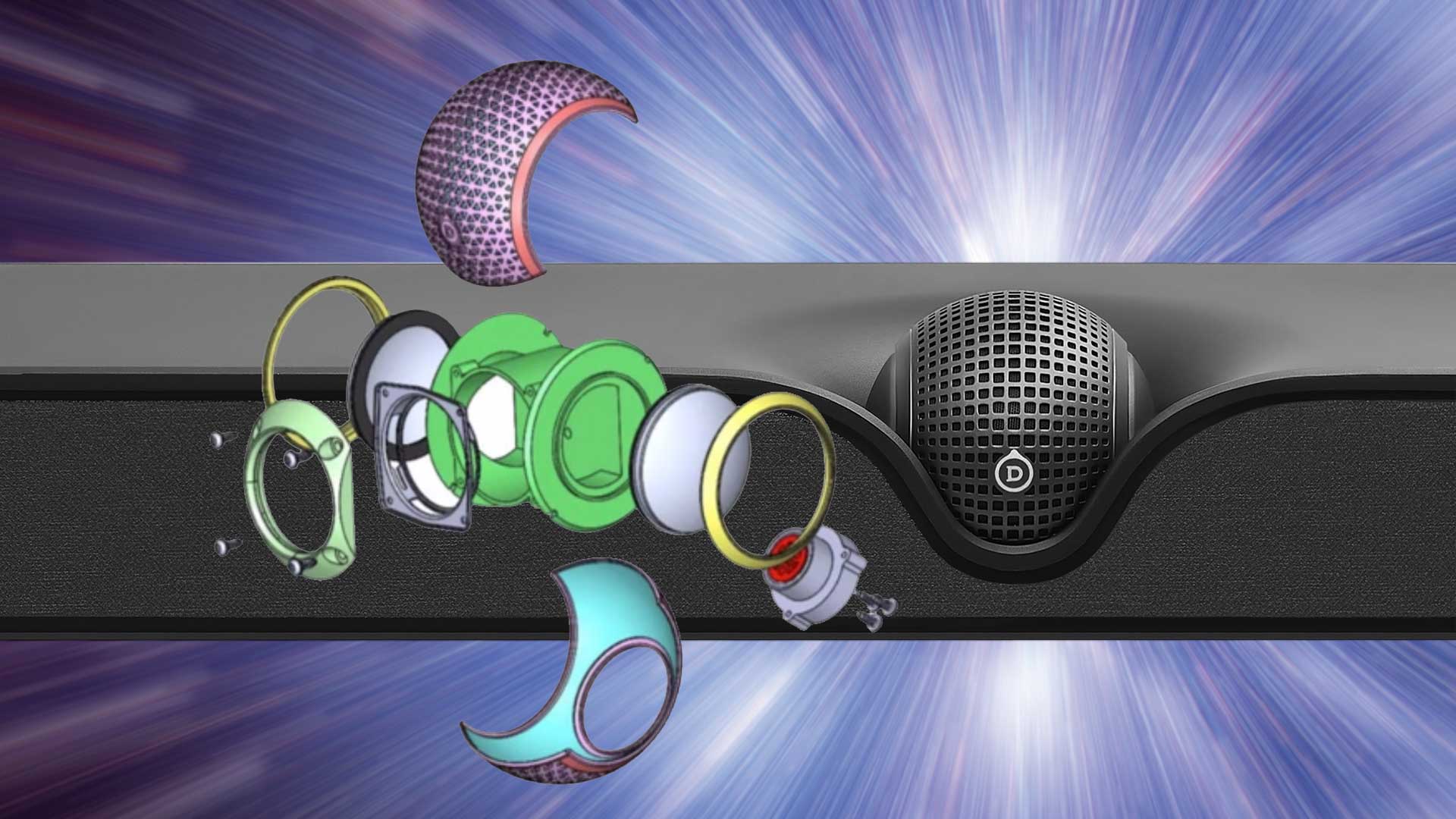
“There’s no trajectory, like in Atmos,” we were told. “We use real-time analysis to identify the reverberant ambience, take it away from the direct sound and then fire to you the direct sound, while enhancing the soundstage with the ambience. If you have a live concert, say, the music will stay upfront while the applause may cover the rest of the room, and this doesn’t deform the signal too much. It works well with concerts, it works very well with action movies. For basic music this is not the best case, and so you can go back to stereo any time you like.”
So the Dione’s beam-forming aims to send side-firing ambience off with the hope of bouncing off available side walls, while upfiring beam-forming does the same with height information and your ceiling. The overall performance of the Dione is described as 5.1.2, including the race-track ‘subwoofer’ drivers as the bass channel.
So, a fair whack of money for a soundbar, but then a lot of technology. How does it sound when you plug it up and play a movie?

Sound performance

Every time a Devialet comes to visit, it brings with it a host of acronyms. A few are new to the Dione; others are established technologies used on other products. Allow us to lexicographically enlighten you…
.
ADE (Advanced Dimensional Experience) is a signal processing algorithm; it “combines ingenious speaker placement detection and advance digital filters to deliver superior multichannel audio through beamforming techniques”.
.
ADH is Devialet’s longterm analogue-digital hybrid amplification technology. The way they explain it, four digital amplifiers provide the grunt of amplification, while an analogue amplifier “determines the load’s output voltage, correcting and completing the signal the digital amplification delivers”. This, the company claims, combines analogue precision with the power and efficiency of digital.
.
AVL “adjusts lower sound levels for a more enjoyable viewing experience”, either as a night-mode or to overcome the common scenario where movies mixed for the theatre require turning up to hear dialogue then down again when the explosions start.
.
SAM is Devialet’s Speaker Active Matching technology, adapting the signal to the characteristics of a speaker, improving linearity and maximising SPLs, while ensuring the system stays within its limits.
.
SPACE (not likely to be an actual acronym, but like ORB, randomly capitalised) actively upscales any stereo signal to the 5.1.2 multichannel configuration of the Dione.
The Dione is certainly an impressively constructed piece of kit. The whole anodised aluminium cabinet’s top curves to create a little gravity well around the central orb, with the front fabric faithfully following the lower curves and extending onto the end sections. All this can’t have been cheap, and we do wonder how much the orb idea and the cabinet’s sweeping curves actually assist the acoustics, or whether they’re only there to deliver some small soupçon of the Phantom’s style.
Underneath the bar (don’t rest it upside-down on the Orb!, warns the manual) are two large hanging holes for wall-mounting, plus a cut-out area with the bar’s fairly minimal physical connections – one HDMI 2.1 eARC socket and the power on one side, optical in and an Ethernet connection at the other. There are no separate HDMI inputs for connecting sources, so the idea is for this bar to take its audio entirely from your TV using the HDMI Audio Return Channel.
If your TV has only plain ARC, you can still enjoy compressed Dolby Atmos through to the bar; if it’s a recent model with eARC to match the bar’s ‘enhanced’ ARC, then full-bloodied Atmos can flow. If you have no ARC at all, you can use the optical connection.
The bar supports and processes Dolby Atmos and other lesser Dolby formats. But here, as on the Bowers & Wilkins bar, there’s no official support for DTS. That’s a licensing fee saved, since no streaming service of note is offering DTS, and very few TVs will even allow DTS to pass through to a connected device (because DTS charges a fee even for that).
However, if you have a source or TV which can decode DTS and then output it as linear PCM, the Devialet should be able to extract its surround elements, we were told, handling multichannel PCM up to 5.1.2 or 7.1, with the company mentioning games on consoles as one possible use for this. Both the PS5 and recent Xbox consoles seem able to do this conversion from DTS to LPCM.
Again as with the Bowers & Wilkins soundbar, there’s no remote control supplied, Devialet noting that you don’t really need one since your TV remote will control volume through HDMI-CEC. If you’re lucky enough to have a Devialet Phantom speaker, the remote for that will control volume, play/pause and next track for music on the bar as well.
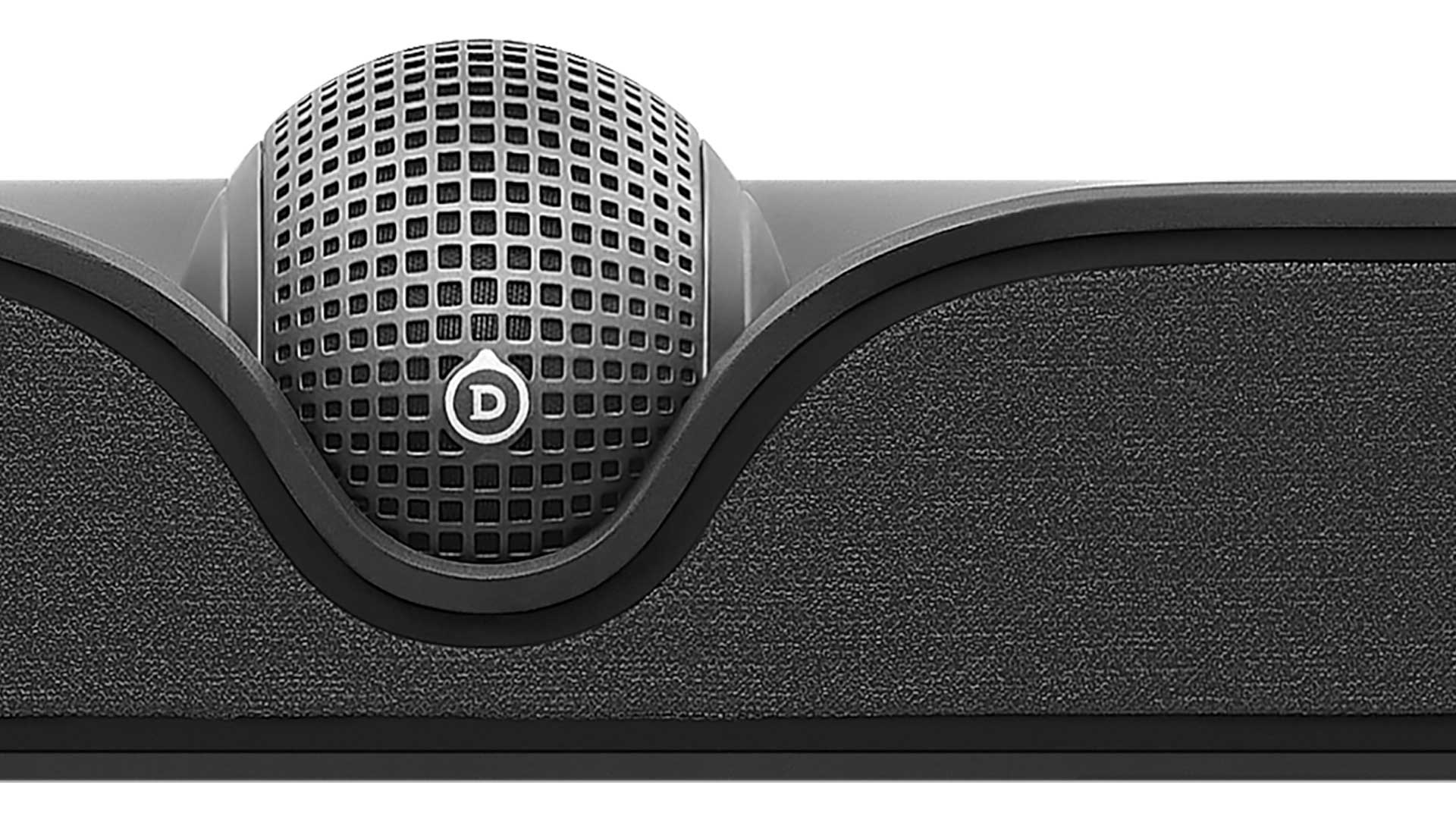
Configuration: 5.1.2 channels (Dolby Atmos, Dolby True HD, DD+, LPCM)
Inputs: HDMI eARC, optical digital, Ethernet, Wi-Fi, Spotify Connect, AirPlay 2, Bluetooth (SBC, AAC)
Drivers: 9 x 41mm aluminiu-dome mid-tweeters,
7 x 133mm bass
Quoted frequency response: 24Hz–21kHz -3dB
Dimensions: 120 x 7.7 (88 with Orb) x 165mm
Weight: 12kg
Or you can use the Devialet app (shown above), which also walks you through getting the Dione on Wi-Fi if you’re not plugging it in to Ethernet. The app has some nice touches. When it first finds the Dione it declares “New life found”. When you go to the Home section, it says ‘Welcome home’. Ain’t that nice.
This app also gives you control over the Dione’s four audio modes – Movies, Music, Voice and ‘Spatial’. There is format detection, we gather, but you can set your preference for each source within the app.
Why network the bar? Because it doubles as a streaming music machine. There’s Spotify Connect onboard, also AirPlay 2 for direct streaming from Apple devices, and Bluetooth as well, though only with SBC and AAC codecs, we are told, so Android device users may get their best quality addressing it via UPnP, using any UPnP app to send music to the Dione across the network.
As this unit was brand-new from the box, we left it on casual TV duties for a full week before we sat down to judge specifics; during that time it barely put a foot wrong, other than some early sync issues with the eARC from our Samsung TV, and delays in the TV detecting the bar and handing over the audio feed. These were nearly entirely fixed by switching the TV to pass through all connected audio. And the quality of the Dione’s sound soon had us forgetting any glitches pretty quickly.
Interestingly, during this casual week, we hadn’t noted the bar as being particularly spectacular in performance, but we were aware that it had never once irritated us either. That’s actually of great value – you don’t want a bar that throws everything in your face all the time. The Dione was able to play things casual when we wanted to do so. But then we found it could seriously impress when we got serious.

We began our critical listening, however, with some music, playing at moderate volume while working, tunes thrown from the Apple Music app on a Macbook Pro over to the Dione via AirPlay 2.
We nearly always find music from a soundbar to be heavily compromised – but here Dido’s Isobel simply did not sound as if it was coming from a soundbar. There was rich bass, a spacious soundstage with a delightfully aspirant lead vocal and oodles of atmosphere, even a wide stereo spread, so that the drum roll into the middle eight emerged firmly off to the left. What a performance!
We combined video with music and gave Hamilton a run in Dolby Atmos from Disney+. This is a production where the bass and the beats are vital to the overall musical effect, and goodness! – how the Devialet had this covered, whether the deep rolling bass line underpinning the delicious Helpless, or the punchy kick drum and organ-like bass underpinning Wait For It.
With Hamilton’s score it was clear that the Dione was not merely competent, not just ‘acceptable for a soundbar’; this was a large-scale musical performance at hi-fi levels of quality. So we must temper our truism that soundbars are an inevitable compromise in audio terms; Devialet has found a way, and the Dione, like its namesake, is indeed a diva.
No subwoofer here, of course, but you needn’t worry about missing something in the lower frequencies. In Obi-Wan E03 the Fifth Brother character (played by Sung Kang) is given a ridiculous halo of bass surrounding his speech; this was delivered by the Dione as, well, suitably ridiculous.
More realistic dialogue emerges marvellously realistically as well. Sometimes in soundbars a strong bass can make male vocals bloom, or processing designed to keep dialogue clear makes things a little too edgy. Not here. Voices sound like voices, while the musical soundtracks and effects all take their place. We’d already heard how the Dione did well with musical bass, and soundtrack bass is handled equally well.
The Devialet delivered the deep hums beneath the sizzling swish of light sabres, and bounced forth the big banging tympani rolling in the deep as Kenobi awaits Vader’s appearance. When Darth does finally stride out, all shiny and black, you’re fully focused on the action, not the soundtrack. This is as it should be!
The official specs on that remarkable bass is that the Dione can reproduce down to 24Hz -3dB, which should leave enough of a curve to create audible sound at the very lower limits of hearing. And from a subwoofer-less soundbar! It’s a remarkable achievement.
All the more so in this depth not masking midrange and treble details. There are no dedicated tweeters in the Dione, only ‘full-range’ drivers (which are really handling mainly mids and highs), so that you might expect treble detail to suffer somewhat as these drivers take on such a wide range of frequencies.
But apparently not. As already evidenced during our music listening, the treble trips pretty lightly from the Dione’s many domes, whether providing the cues that allow easy speech intelligibility, or twinkling with the details added by some hard-working sound designer.
This is most obviously clear when the bar receives a genuine Dolby Atmos soundtrack, and the Dione really gets to present its best. We loaded Alita Battle Angel on UHD Blu-ray, and as often happens, the quality of a disc-based soundtrack was entirely apparent, with ravishing depth for the ominous rumbling through every action scene in the movie, and effects thrownout to massive width, for example during the street-based Motorball practice game. It’s a BIG sound.
We turned back to Disney+ to hear how the Dione handled the amazing 1947 Partition scenes in E05 of Ms Marvel. This is a distracting sequence in every way, and a challenge for any system to keep the dialogue under control against the background hubbub of the crowd, the innovative musical soundtrack and the growing chaos of the railway station. Again the Dione excelled, effects were spread wide, and if there was the slightest impression up at high volumes that the deeper rumbling effects were swamping higher frequencies, it never overly softened dialogue, nor took away from the soaring strings over the climax.
It’s hard to judge the effect of the room calibration, as you can’t turn it on and off, or only by deleting the scan and running another. We couldn’t pick a difference when we did so, so at least it wasn’t destructive.
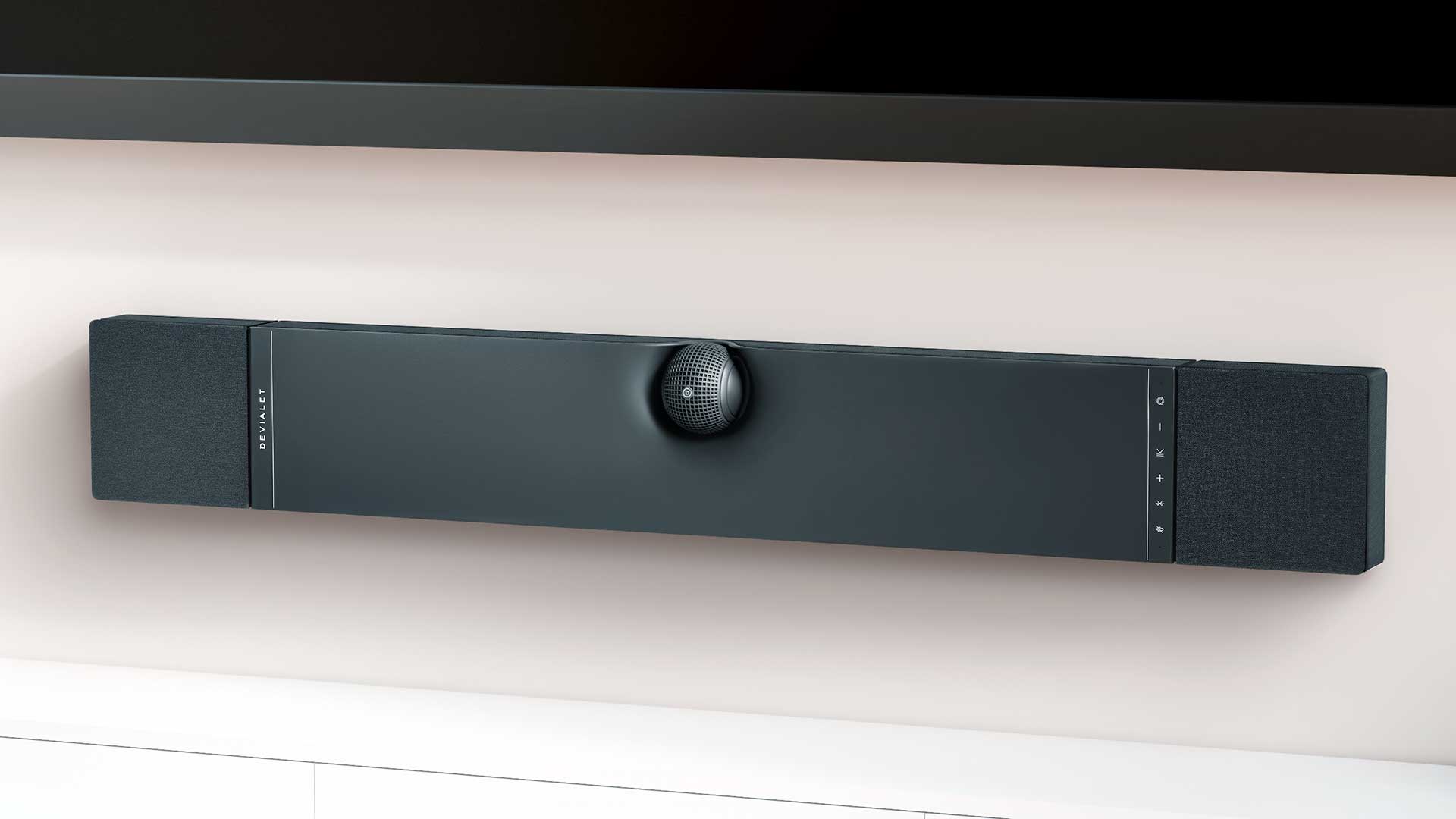
Verdict
The price here is such that we find it hard to fully recommend the Dione without also suggesting you look at other ways to spend the money, especially if you’re considering a soundbar to replace an existing audio system; there may be upgrade options, even a home cinema surround package, that you could put together for this price.
But that’s not really the point of the Dione, which is to deliver the convenience of a one-box soundbar, along with performance far beyond that expected of the genre. At the price we must compare it with Sennheiser’s Ambeo soundbar, the sound is which is even larger and, we thought, achieved a wider spread of sound, at least in our room which doesn’t have narrow side walls to assist the Dione’s beam-forming bouncing.
But the Ambeo bar is also significantly larger in every dimension, including the important one of height; the Dione is more likely to fit under your TV at 8cm high than the Ambeo at more than 13cm.
The Dione is also far more impressive in design terms, with those curves and Orb. It’s sonically less dominant too; we loved how it didn’t overwhelm when we just wanted to enjoy some casual daytime telly, and yet when we loaded a movie and cranked up the Atmos it would amaze us with the spread, the size and the depth of sound, all while keeping dialogue clear and our attention fixed on the movie. Sure it’s pricey. But it is brilliant.

Jez is the Editor of Sound+Image magazine, having inhabited that role since 2006, more or less a lustrum after departing his UK homeland to adopt an additional nationality under the more favourable climes and skies of Australia. Prior to his desertion he was Editor of the UK's Stuff magazine, and before that Editor of What Hi-Fi? magazine, and before that of the erstwhile Audiophile magazine and of Electronics Today International. He makes music as well as enjoying it, is alarmingly wedded to the notion that Led Zeppelin remains the highest point of rock'n'roll yet attained, though remains willing to assess modern pretenders. He lives in a modest shack on Sydney's Northern Beaches with his Canadian wife Deanna, a rescue greyhound called Jewels, and an assortment of changing wildlife under care. If you're seeking his articles by clicking this profile, you'll see far more of them by switching to the Australian version of WHF.
